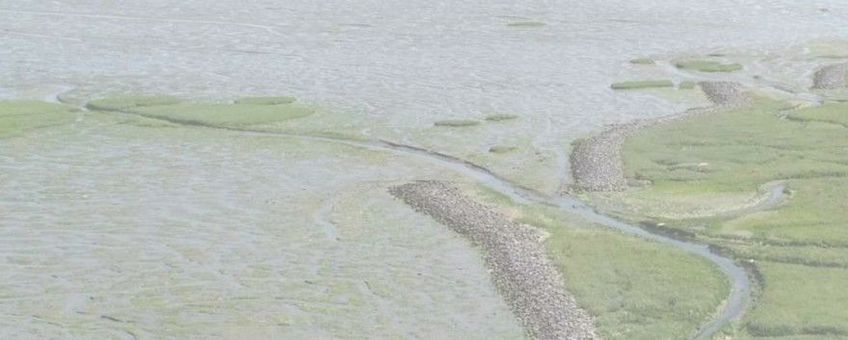
Nature can help protect against sea level rise
NIOZ Royal Netherlands Institute for Sea ResearchIn the exploratory study ‘Meegroeien’, water experts outline how nature can help protect us from rising sea levels in the future. By giving space to water, sand, and silt, coastal areas can naturally raise themselves and grow along with the sea level. This creates a broad, resilient transition zone between sea and land, with marshes, dunes and intertidal areas: a broad ‘buffer’ that protects the hinterland. The risk of a dyke breach is reduced, and in the event of a breach, the consequences are less severe. The safety standard remains unchanged, but the form changes: from hard defences to robust, naturally moving landscapes.
Also good for nature
Another advantage is that the characteristic and valuable intertidal areas in the Zeeland delta and the Wadden Sea, with their enormous biodiversity, will be preserved and even enhanced. These wet nature areas are important for the millions of migratory birds that fly over the country every year and depend on the food they find on the border between water and land. They also capture CO2.
Focus on life and liveability
According to Jim van Belzen, estuarine ecologist at Wageningen Marine Research and the Royal Netherlands Institute for Sea Research (NIOZ) and one of the authors of the study, this is a fundamentally different way of thinking about our future in the delta. "The starting point for this ‘Meegroeien’ study was a new nature-based approach for the long term. Compared to the three other studies, namely ‘Protect’, ‘Move with the tide’, and ‘Seaward’, which were developed for the Sea Level Rise Knowledge Programme, this line of thinking is the only one that not only has water safety and freshwater availability as its goal, but also the preservation of robust ecosystems. In my opinion, this makes it the only approach that truly focuses on life and liveability."
Not more expensive...
According to Van Belzen, the alternative is not more expensive than other scenarios. “Extra space is needed to capture sediment, but that space will eventually be needed for many other solutions as well. It was an eye-opener for us that much of the cost lies in repeatedly reclaiming space, so it is better to do it right the first time. In our strategy, we include that space from the outset to allow dyke landscapes to grow.”
...and it offers economic benefits
The study shows that, in addition to nature, economic sectors such as shellfish farming, recreation, and tourism also benefit from the restoration of natural dynamics. Van Belzen: “This approach builds on the centuries-old Dutch tradition of living with water and takes it a step further: restoring the natural engine that made our delta great. This not only creates a safe coastline, but also a richer ecosystem, a more stable freshwater supply, and a more attractive living environment for future generations.”
The Netherlands, a water country
Minister Tieman of Infrastructure and Water Management is pleased with the fourth line of thinking that has been brought to light by the new research. "The Netherlands is a water country with a wealth of knowledge. We are proud of that, and we will need that expertise if sea levels rise in the future and we want to continue to live safely. We are already using dynamic coastal management in the dunes, where the sea and wind supply sand and raise the dunes. This research shows that we can use these natural processes even more widely to keep our delta safe and that we can include this as an option in our toolbox."
About the Sea Level Rise Knowledge Programme
The Sea Level Rise Knowledge Programme (Kennisprogramma Zeespiegelstijging; KPZSS) is part of the Delta Programme and is being implemented under the direction of the Delta Programme Commissioner and the Department for Infrastructure and the Environment. In the programme, governments, knowledge institutions, companies, and civil society organisations work together to investigate what rising sea levels mean for the Netherlands and what choices are now necessary to keep the country safe and liveable in the long term.
The ‘Meegroeien’ study complements earlier research by the Sea Level Rise Knowledge Programme, which used three approaches – ‘Beschermen’ (Protect), ‘Meebewegen’ (Move with the tide), and ‘Zeewaarts’ (Seawards) – to investigate how the Netherlands can remain safe in the future. These studies showed that it is possible to protect the Netherlands in various ways against a sea level rise of five metres, but that the consequences for the spatial planning of our country and nature are far-reaching.
More information
- Report 'Meegroeien met zeespiegelstijging' in Dutch.
- Umbrella report 'Ruimte voor zeespiegelstijging' in Dutch.
Text and images: NIOZ
